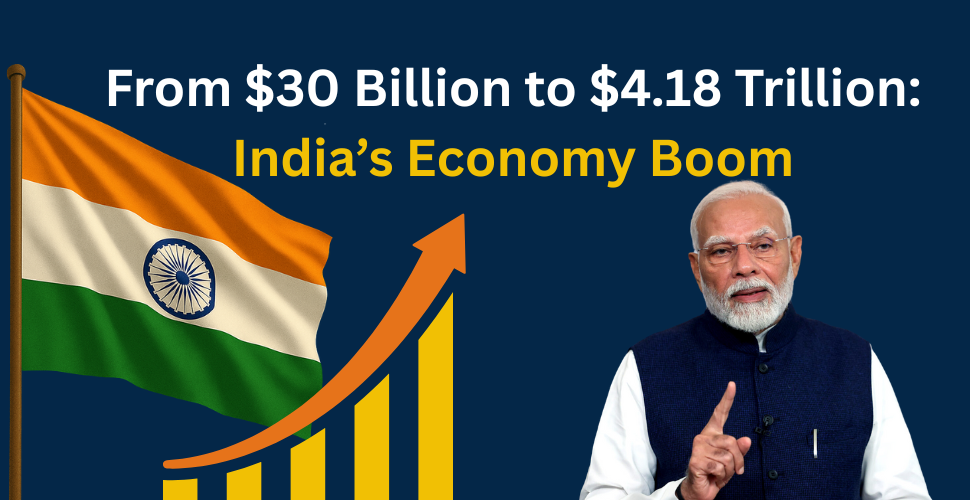India has officially surpassed Japan to become the fourth-largest economy in the world, according to the International Monetary Fund (IMF). With a nominal GDP of $4.18 trillion, India now stands behind only the United States, China, and Germany.
This is more than a statistical achievement — it’s a reflection of India’s decades-long journey of reforms, resilience, and reinvention. In this blog, we explore how India reached this historic milestone, the key drivers behind its rise, and what lies ahead.
India’s GDP
$4.18
Current GDP (USD Trillion)
Global Rank
#4
Position in World Economy
India’s Economic Milestones Since 1947
- 1947: Independence, GDP around $30 billion.
- 1991: Liberalization reforms start.
- 2008: India crosses $1 trillion GDP.
- 2022: Becomes 5th largest economy, overtakes the UK.
- 2025: Overtakes Japan, becomes 4th largest economy.
India’s rapid economic acceleration began in the early 1990s when it opened its markets and embraced globalization. Since then, reforms in taxation, infrastructure, technology, and governance have set the foundation for sustained growth.
India’s Journey to Becoming the World’s 4th Largest Economy
India’s rise to a $4 trillion economy is not a miracle — it’s a result of decades of reform, innovation, and determination. Explore the powerful forces that have propelled India ahead of Japan and into the elite club of top global economies.
🚀 Game-Changing Economic Reforms
- 1991 Economic Liberalization: Marked a bold shift from protectionism to openness, attracting global investors and boosting competition.
- Goods and Services Tax (GST): Created a unified national market, reducing logistical inefficiencies and tax barriers.
- Startup India & Digital India: Gave rise to over 100 unicorns and fostered a culture of entrepreneurship and innovation.
👩🎓 Demographic Powerhouse of Youth
- Largest Young Population: With an average age of 28, India has a dynamic, ambitious, and digital-native workforce.
- Skilled Talent Pool: A growing emphasis on education, engineering, and digital skills is driving innovation and global service leadership.
💡 Tech-Driven Digital Revolution
- UPI, Aadhaar & Jan Dhan: Created the world’s largest digital financial inclusion network.
- Digital Payment Leadership: India leads globally in real-time digital transactions, reshaping the financial landscape.
- GovTech Initiatives: Seamless digital delivery of services has made governance more transparent and inclusive.
📈 Booming Domestic Consumption
- Growing Middle Class: Rising incomes are fueling demand for better products, homes, and lifestyles.
- Rural Aspiration: Improved connectivity and infrastructure are driving consumption beyond cities.
- Sectors on Fire: FMCG, e-commerce, real estate, and automobiles are among the high-growth engines of the economy.
🖥️ Services
Includes IT, finance, telecom, and more. Backbone of the economy.
~53%Manufacturing, infrastructure, and industrial production.
~25%🌾 Agriculture
Vital for rural livelihoods, food security, and exports.
~17%📦 Others
Miscellaneous economic contributions including informal sectors.
~5%💰 $10 Trillion Economy
India aims to become a $10 trillion economy through sustained growth, high productivity, and a digital-first approach across sectors.
🏞️ Viksit Rajya: State-Led Progress
States are key to the Viksit Bharat mission. Each is building its own roadmap to contribute to the national vision of inclusive development.
🌱 Sustainability & Green Leadership
India is poised to lead in green energy, circular economy practices, and climate resilience, aligning growth with global environmental goals.
🌐 Digital Public Infrastructure
Expanding India’s tech stack—from UPI to AI—to enhance public services, governance, and digital access for all citizens.
🎓 Innovation, Education & Talent
Investments in skill development, world-class institutions, and R&D will drive India’s innovation-led future.
🛤️ Infrastructure & Connectivity
Next-gen roads, rail, smart cities, and digital highways will fuel mobility, commerce, and productivity.
Global Impact: Why the World Is Watching India
As India climbs the global economic ladder, its influence on world affairs is also growing. From climate talks to supply chain realignments, India’s voice is more powerful than ever. Investors, policymakers, and innovators globally are now turning their focus towards India’s expanding role in:
- • Global diplomacy and trade agreements
- • Clean energy and climate action
- • International startup and tech partnerships
- • Peacekeeping and regional stability
Expert Insights
Leading economists and global leaders have highlighted India’s unique position and sustainable growth path:
“India’s growth trajectory is not just rapid—it’s sustainable, diversified, and digitally empowered.”
— IMF Chief Economist
“India is setting a new benchmark in climate leadership and inclusive innovation.”
— World Bank Regional Director
Final Thought
Do you believe India will surpass Germany by 2027? Share your thoughts in the comments below and don’t forget to spread the word by sharing this article with #ViksitBharat.
🔴 Challenges
- Rising income inequality and regional disparities
- Job creation to match a growing population
- Infrastructure gaps in Tier 2 and Tier 3 cities
- Policy consistency and global trade uncertainties
🟢 Opportunities
- Positioning India as a global manufacturing powerhouse
- Leading the charge in climate-friendly technologies
- Exporting skilled human capital across the globe
- Scaling agri-tech and health-tech ecosystems





